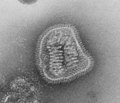File:Influenza virus particle 8430 lores.jpg
Appearance

Size of this preview: 701 × 600 pixels. Other resolutions: 281 × 240 pixels | 561 × 480 pixels | 898 × 768 pixels | 1,197 × 1,024 pixels | 1,663 × 1,423 pixels.
Original file (1,663 × 1,423 pixels, file size: 763 KB, MIME type: image/jpeg)
File history
Click on a date/time to view the file as it appeared at that time.
| Date/Time | Thumbnail | Dimensions | User | Comment | |
|---|---|---|---|---|---|
| current | 08:45, 19 November 2010 |  | 1,663 × 1,423 (763 KB) | Masur | original resolution |
| 19:35, 2 May 2006 |  | 700 × 598 (45 KB) | Patho | {{Information| |Description=PHIL Image 8430 ID#: 8430 Description: This negative-stained transmission electron micrograph (TEM) depicts the ultrastructural details of an influenza virus particle, or “virion”. A member of the taxonomic family Orthomyx |
File usage
The following 6 pages use this file:
Global file usage
The following other wikis use this file:
- Usage on be.wikipedia.org
- Usage on cs.wikipedia.org
- Usage on de.wikipedia.org
- Usage on de.wikibooks.org
- Usage on es.wikipedia.org
- Usage on et.wikipedia.org
- Usage on eu.wikipedia.org
- Usage on fa.wikipedia.org
- Usage on fr.wikipedia.org
- Usage on he.wikipedia.org
- Usage on hy.wikipedia.org
- Usage on it.wikipedia.org
- Usage on ja.wikipedia.org
- Usage on lt.wikipedia.org
- Usage on ml.wikipedia.org
- Usage on nl.wikipedia.org
- Usage on ru.wikipedia.org
- Usage on sr.wikipedia.org



